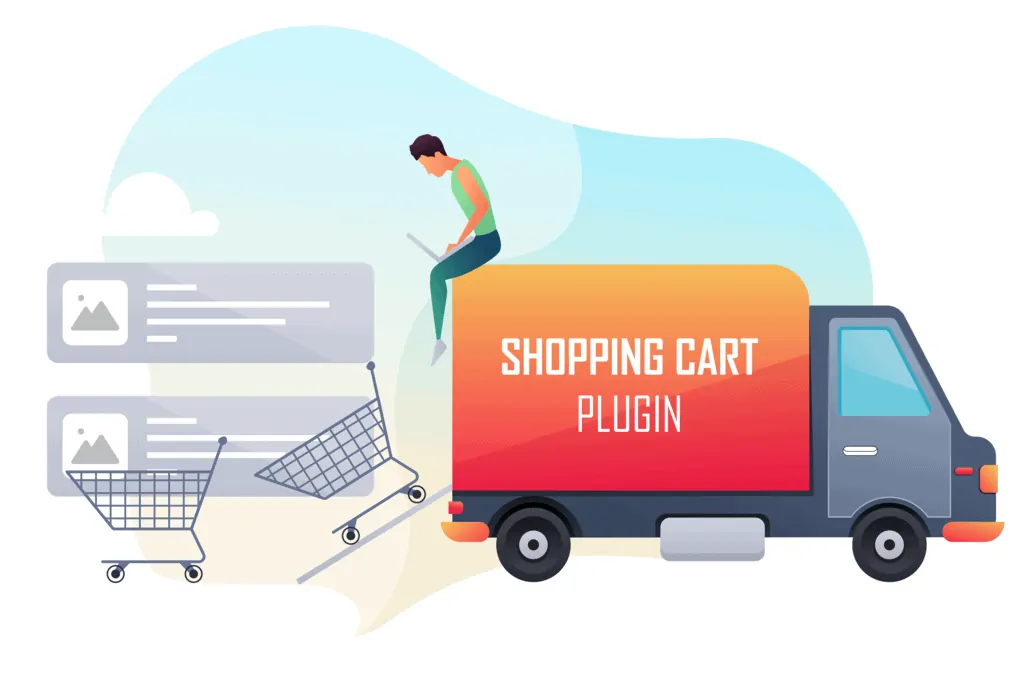
Today’s shopping carts have transformed the confusing code, page interfacing tools, and payment processing into a fast and easy process.
You’ll still need to do a bit of legwork in getting your online store ready to launch. That’s where understanding how an online shopping cart works on the back end of your online dashboard can be a huge asset.
Choices of online shopping carts are beyond plentiful. While the basic premise behind them is all the same, but look for a shopping cart plugin that gives you the best features that you need to grow your online business, while also being simple enough to not put off potential buyer is you ever decide to sell your website on.
If you want the quick answer, we like 3dCart which can be installed directly to a WordPress site via a plugin, but there are more options below.
Table of Contents
What Happens When You Add A Shopping Cart To Your Website?
Many of the shopping cart platforms are very easy to install, even for a beginner. Whether you are a novice DIY website builder or a seasoned tech-navigator, it helps to have a good understanding of exactly how a shopping cart works.
When you want to buy something from a store, the display windows attract your attention. Once you’re inside the store, you get a chance to look around. The cashier desk takes care of the money and bags your purchases before you leave the store. You probably don’t notice that backroom, where all the lovely merchandise is kept in an orderly manner.
A website shopping cart works much the same way that a brick and mortar store works. Shopping cart plugins also have a display window, a storefront, and a backroom. The operations in each section of your online store are written in code on your site’s dashboard.
Your dashboard acts as the backroom, where all the behind-the-scenes work takes place before your customers see the nicely displayed products on the front pages of your online store. The shopping pages are linked together using a programming language like PERL or JavaScript.
Your customers will be more inclined to shop at your online store when they know that it is secure. Make sure that your shopping platform runs on SSL, which is an acronym for secure sockets layer.
SSL encrypts your buyer’s payment information, like code, so that hackers can’t hack into their personal information while they are making their transaction. Watch this video to better understand how SSL works:
They’ll know that your site is secure if it begins with https://. The “s” after the http tells the buyer that your site is secure.
You will need to open a merchant account like PayPal, which acts as your merchant account and the payment gateway. The merchant account holds money during transactions before it is moved to the buyer or seller. The payment gateway is an online mechanism for processing credit card payments.
When your customer hits a button to purchase one of your items, the shopping cart sends the payment to the payment gateway. The gateway finds the correct credit card company and sends a request to charge the credit card for the total amount of purchase. The credit card company validates the account and makes a decision to approve or deny the charge. If the card isn’t approved, it sends a message back telling you why it couldn’t be processed.
If the charge is approved, the gateway sends a message back saying the money can be transferred and tells the shopping cart that the transaction was successful. The gateway generates a request to the store’s merchant account asking the credit card to add funds to the store’s merchant account. Typically, you can access your money within 3-7 days.
How To Add A Shopping Cart To Your Site
The online shopping cart plugins do most of the backroom duties for you, but you’ll still have to set up the pages on your site and manage your products. Allow about an hour to get your store fully set up. It will take just minutes to manage your inventory after the initial installation.
Your shopping platform will direct you to the link to click to start the shopping cart installation. Once you get a message that the installation is complete, you’ll need to set up your store pages. Here are some of the things you’ll need to set up:
- Products
- Storefront design
- Checkout process design
- Payment processing
- Shipping charges and options
You’ll usually have a few choices regarding buttons for your customers to click. You might use a button that says “buy” or “add to cart” or something else.
This video shows how to add a Paypal shopping cart to your website. If your shopping cart platform doesn’t do it for you, this video explains how to get the HTML code for your buy button and copy and paste it onto your product pages. You can change the size and color of the button. You can also be creative and use an image other than a button, like a dollar sign or shopping cart image.
WordPress is one of the most popular platforms for websites and blogging. WordPress developed an easy-to-use WordPress Simple Shopping Cart for your site.
One of the nicest features of this shopping cart is that you can add an “add to cart” button for your product on any of your posts, pages, or sidebars. This plugin dovetails nicely with the NextGen Photo Gallery plugin so that you can pull photos from your image gallery to use for your product pages.
If you plan to sell your products internationally, you can also use plugins for translations in 14 different languages.
If you’re looking for additional features when you add a shopping cart to your website, there are literally hundreds of other shopping cart plugins available. Here are some of the popular choices:
- Shopify
- Square online store
- Volusion
- Zoey Commerce
- Pinnacle Cart
- Miva Merchant
- Magento
- 3dcart
- BigCommerce
- SparkPay Online Store Builder
- LemonStand
- Ashop
- ShopSite
- PrestaShop
- WooCommerce
Getting All the Best Features When You Add A Shopping Cart to Your Website

Product images: all online platforms let you add images, but most people want to see clearly what they are buying. You’ll want to have the capability to resize the images to display your product in the best way possible. This means you’ll want to make it large enough for customers to see it clearly, without it taking over the whole design of the page. Customers also like the zooming feature so they can see the details clearly.
Simplicity: if you have a product to sell, you’ll want to get it up online where customers can see it quickly. A shopping cart platform that takes more than an hour to set up is probably not worth your time, especially if you only have a few products to sell.
Search engine friendly: your marketing plan will be a step ahead of the game if your shopping cart sets up your product pages to be commerce-enabled, which many of them do. Having this feature means that your site will be easily indexed y all search engines.
Product reviews: your customers are more likely to trust your site and buy your products if other buyers loved them. A product that has dozens of top-rated consumer reviews will be an easy choice for the buyer that is on the fence about purchasing it.
Search box: it might seem surprising how effective a simple tool like a search box can be to sell an item. Most shoppers have a pretty good idea of what they want. Rather than page through pages upon pages of products, a search box quickly takes them to the products they’re looking for. This feature is a “must” for anyone selling many types of products.
Coupons and discounts: extreme couponing isn’t just for the grocery stores. Many new sites that direct coupon seekers to sites for deals like Groupon have sprung up. Living Social, RetailMeNot, Offers.com, and Google Deals. You may want your site to be able to integrate with these discount sites so that you can expand your customer base. Your shopping cart may also be able to add discounts and coupons.
Analytics and Sales Reporting: the only way for you to know if you’re making money is to analyze your results and track your sales. If a product isn’t selling, you may want to pull it in favor of a more attractive product. Your shopping cart may come equipped with this feature or it may interface nicely with Google analytics. It’s also nice if you can easily export your sales reports.
Integration with Other Business Tools: for sellers with large sales volumes, it’s helpful to interface your online shopping cart with Quickbooks, or a similar accounting program. If you’re looking to do some strong email marketing, it will be worthwhile to find a shopping cart plugin that easily interfaces with e-marketing platforms like Constant Contact.

Our #1 Choice For Hosting Blogs
62% Off Exclusive Offer Applied at Checkout
Regularly
$6.95/mo
Starting From
$2.64/mo*
- Free 1 Year Domain Registration on Select Plans
- FREE SSL Certificate
- Drag-and-drop Website Builder
- E-commerce Ready
- 1-Click WordPress Installation



